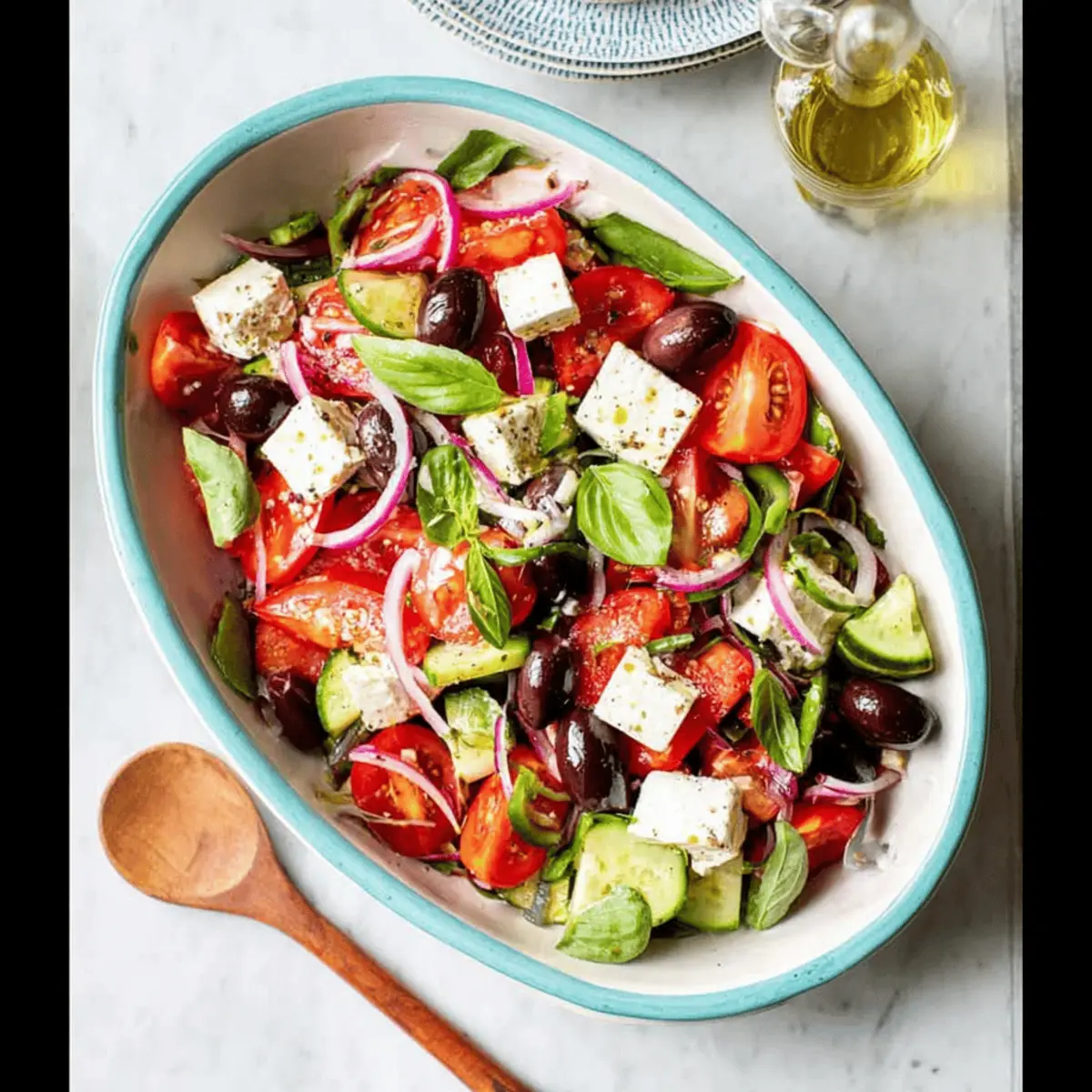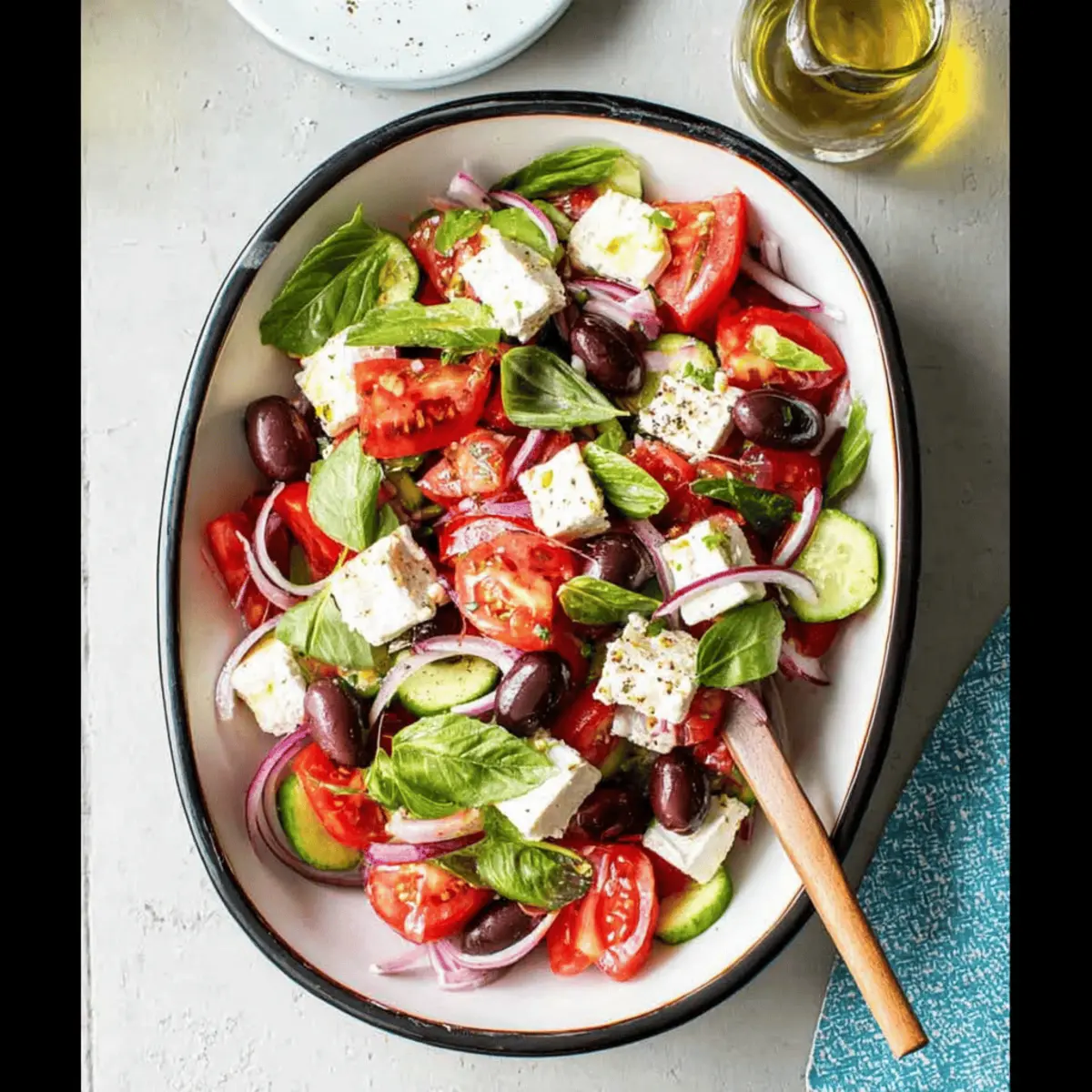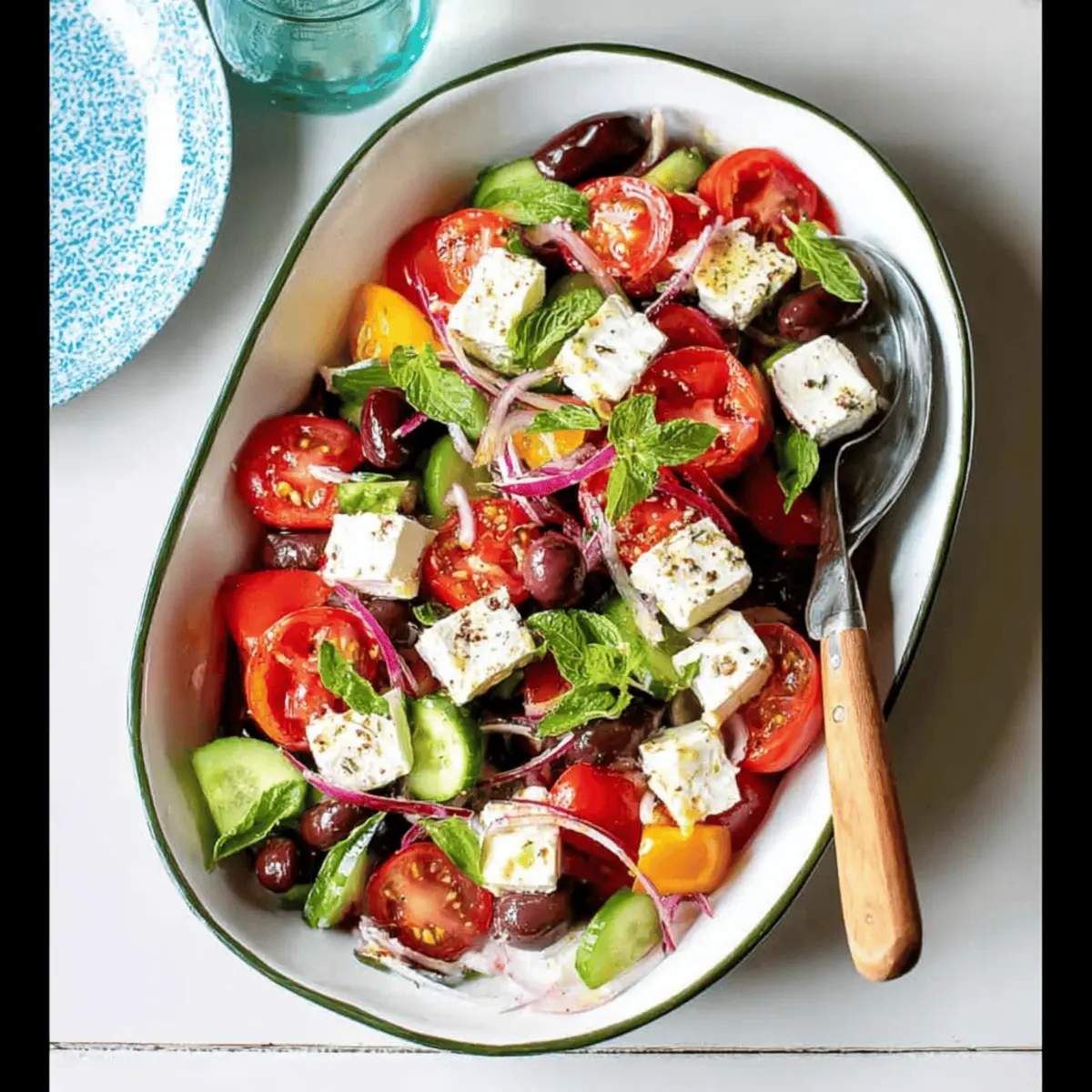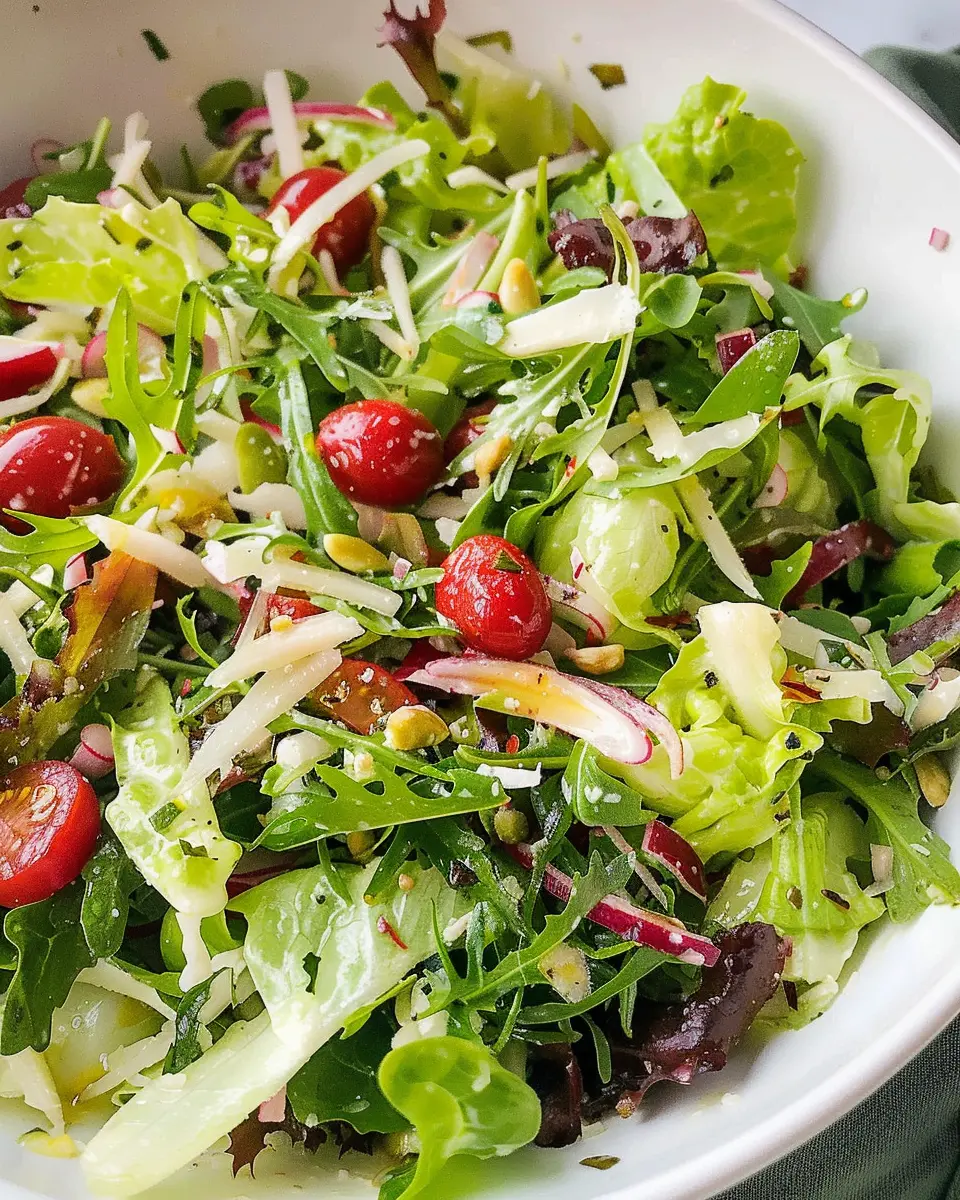Introduction to Greek Salad
A journey through flavors and memories
When you think of a Greek salad, what comes to mind? Perhaps a vibrant mix of colors, refreshing tastes, and a hint of nostalgia. For many, these familiar ingredients conjure memories of sun-soaked summers spent in Greece or cozy meals with loved ones. This classic dish isn’t just a recipe; it’s a celebration of life, simplicity, and the Mediterranean spirit.
A traditional Greek salad, or Horiatiki, showcases fresh vegetables like juicy tomatoes, crisp cucumbers, bell peppers, and red onions, all tossed together with rich Kalamata olives and a sprinkle of tangy feta cheese. The dressing, often a blend of olive oil, red wine vinegar, oregano, and salt, captures the essence of the Mediterranean region. This combination not only creates a stunning visual feast but also bursts with incredible flavors that delight the palate.
One of the standout aspects of this savory side dish is its versatility. You can enjoy it as a part of a larger meal or as a light, standalone dish. According to experts at the Mediterranean Diet Foundation, diets rich in vegetables, such as those featured in a Greek salad, are linked to numerous health benefits, including reduced risk of chronic diseases and improved heart health.
As you gather your ingredients, take a moment to appreciate their freshness—maybe even source them from your local farmer’s market. Organic produce not only tastes better but also supports sustainable practices. Did you know that using fresh, seasonal vegetables can enhance the flavor profile of your Greek salad? It’s true!
As we dive deeper into crafting our own versions, think about what memories you’re creating around this dish. Whether it’s a casual dinner with friends or a vibrant picnic on the beach, a well-made Greek salad stands as a testament to the joys of simple, yet impactful cooking.
So, grab your chopping board, and let’s explore how to bring this delightful dish to life in your kitchen!

Ingredients for Greek Salad
Essential ingredients for a classic Greek salad
To whip up a traditional Greek salad, you’ll need a handful of essential ingredients that work together to create that fresh, Mediterranean flavor. Here’s what you should gather:
- Cucumbers: Crisp and refreshing, they add a perfect crunch.
- Tomatoes: Juicy, ripe tomatoes bring vibrant color and sweetness.
- Red onion: Thinly sliced for a bit of bite, balancing the salad beautifully.
- Bell peppers: Traditionally green, but any color adds a splash of brightness.
- Kalamata olives: These salty gems are a must for authentic flavor.
- Feta cheese: Crumbled or in blocks, this tangy cheese is the star of the show.
- Olive oil: Extra virgin is ideal for drizzling over the top.
These ingredients come together in harmony, reflecting the heart of Greek cuisine. For a deeper dive into the nutritional benefits of these ingredients, check out Healthline’s guide on Mediterranean diets.
Optional ingredients for customization
Feel free to make your Greek salad unique! Consider adding:
- Capers: A zesty addition for extra flavor.
- Avocado: For creaminess that plays well with the acidity.
- Herbs: Fresh oregano or parsley can elevate the aroma.
- Lemon juice: A squeeze can brighten the flavors even more.
Personal touch matters! Have you ever added something unexpected to a Greek salad? Share your secret in the comments! The best part about this dish is that it can adapt to your taste buds while remaining deliciously Mediterranean.
Preparing Greek Salad
Greek Salad is not just a dish; it’s an experience full of fresh flavors and vibrant colors. If you’ve ever wanted to recreate this Mediterranean delight in your own kitchen, you’re in for a treat! Let’s dive into how to prepare a classic Greek salad that will impress your taste buds and your dinner guests.
Gather your fresh ingredients
Creating a delicious Greek Salad starts with high-quality, fresh ingredients. Here’s what you’ll need:
- Ripe tomatoes (preferably heirloom or vine-ripened)
- Crunchy cucumbers (English or Persian varieties are best)
- Red onion (for a bit of zest)
- Green bell pepper (adds crunch and color)
- Kalamata olives (for the authentic Mediterranean flavor)
- Feta cheese (the creamier, the better)
- Extra virgin olive oil (a staple in Greek cuisine)
- Fresh oregano (dried can work but fresh is truly superior)
- Salt and pepper (to taste)
Don’t skimp on quality! When it comes to ingredients, sourcing organic or locally grown produce can elevate your salad to a culinary masterpiece. For some great tips on selecting fresh vegetables, check out this guide from Healthline.
Chop and prepare vegetables
Now that we have our ingredients, it’s time to start chopping! Prepare the vegetables as follows:
- Tomatoes: Cut them into wedges or bite-sized pieces, ensuring each piece is easy to eat.
- Cucumbers: You can peel them if you prefer a less bitter taste, but I love keeping the skin on for added crunch. Slice them into half-moons or rounds.
- Onion and bell pepper: Slice these thinly; you want the flavors to mingle throughout the salad, but you also want them to remain distinct.
- Olives: If you’re using whole olives, feel free to leave them whole or slice them in half for easier eating.
As you chop, take a moment to appreciate the vibrant colors and smells. It’s a great way to unwind after a long day.
Prepare the dressing
The dressing is what ties a Greek Salad together. Here’s a simple yet flavorful recipe:
- Ingredients:
- 1/4 cup of extra virgin olive oil
- 2 tablespoons of red wine vinegar
- 1 teaspoon of fresh oregano (or 1/2 teaspoon dried)
- Salt and pepper to taste
In a small bowl or jar, whisk together the olive oil and vinegar. Add the oregano and season with salt and pepper. You can also shake it up in a sealed jar for a bit of fun! This dressing is where you can adjust to personal taste. If you like a tangier flavor, add more vinegar!
Assemble the Greek salad
Time to bring all your hard work together! In a large serving bowl, combine:
- The chopped tomatoes
- Cucumbers
- Onions
- Bell peppers
- Kalamata olives
Crumble the feta cheese over the top, allowing it to rest beautifully on the mixture. The visual appeal is just as important as the taste—make it look as stunning as it tastes!
Toss and serve
Before serving, drizzle your prepared dressing over the salad and give it a gentle toss. You want to coat the veggies without crushing anything. For those who prefer their Greek Salad in a more sophisticated manner, consider serving it in individual bowls rather than one large bowl.
And voila! You have a delightful Greek Salad ready to wow your friends or family. Pair it with grilled meats or a warm pita, and you’ve got a meal that feels like a mini-vacation to Greece.
Remember, the best part about a Greek Salad is that there’s plenty of room for personal touch—feel free to explore and add your favorite ingredients. Enjoying this dish not only satisfies your taste buds but it’s also a great way to embrace healthy eating habits. Happy cooking!

Variations on Greek Salad
Greek salad is a beloved classic, but why not add a little flair to it? If you’re like me, you enjoy creatively reinventing traditional dishes. Here are some delightful variations to keep your taste buds excited!
Mediterranean Twist on Greek Salad
Imagine adding a few Mediterranean flavors to your Greek salad; it can be as simple as introducing tangy roasted red peppers or a handful of green olives. You might also consider incorporating artichoke hearts for an extra layer of flavor. If you’re feeling adventurous, try a drizzle of balsamic glaze to bring a sweet undertone to the dish. And let’s not forget a sprinkling of fresh herbs like basil or mint—these can elevate your salad to a whole new level of freshness. If you’re interested in exploring more Mediterranean ingredients, check out this guide to Mediterranean cuisine for culinary inspiration!
Additions Like Grilled Chicken or Chickpeas
For those days when you’re craving a heartier option, why not add some protein to your Greek salad? Grilled chicken is a fantastic choice; simply marinate it in olive oil, lemon juice, and garlic for a few hours, then throw it on the grill for that perfect char. Alternatively, chickpeas are a great plant-based option. Just toss them in olive oil and your favorite spices, then roast them until crispy. Not only do these additions make the salad more filling, but they also increase its nutritional value. According to a study from the Cleveland Clinic, adding protein to salads can significantly enhance satiety, helping you feel fuller longer.
So why not give these variations a try? You might just find your next favorite salad!
Cooking notes for Greek Salad
Tips for Choosing the Freshest Ingredients
When making Greek Salad, the quality of your ingredients can really make or break the dish. Here’s how to pick the best:
- Tomatoes: Look for ripe, vine-grown tomatoes. They should feel heavy for their size and have a rich color. Heirloom varieties are especially flavorful.
- Cucumbers: Select firm cucumbers with smooth skin; these will add the perfect crunch. If you can find locally grown ones, even better!
- Feta Cheese: Go for a block of feta instead of pre-crumbled; it tastes fresher. A nice, tangy sheep’s milk feta brings authentic flavor to your salad.
- Olive Oil: Quality matters! A robust, extra-virgin olive oil elevates your dressing. Check out sites like Olive Oil Times for recommendations.
Storage Tips for Leftover Salad
If you’re lucky enough to have leftovers, store your Greek Salad properly for maximum freshness.
- Refrigerate Promptly: Keep your salad in an airtight container to maintain its crispiness. Aim to eat it within 1-2 days.
- Keep Dressing Separate: If possible, store the dressing separately to prevent the veggies from wilting over time. Just toss when you’re ready to enjoy!
Cultivating a few simple habits like these can significantly enhance your cooking experience and help keep your meals vibrant and tasty!

Serving suggestions for Greek Salad
Perfect Pairings with Main Dishes
Looking for the ideal complement to your Greek Salad? This vibrant dish pairs beautifully with a variety of main courses. Consider serving it alongside grilled chicken or lamb for a Mediterranean twist. Fish, especially grilled salmon or sardines, also enhances the fresh flavors of the salad. You might also enjoy it with a rich, hearty dish like moussaka or baked eggplant.
Additionally, for a vegetarian feast, pair your Greek Salad with stuffed peppers or falafel. The zesty flavors and crunchy textures elevate any meal, balancing rich dishes with light, refreshing bites.
Creative Serving Ideas for Gatherings
Hosting a get-together? Transform your Greek Salad into a crowd-pleaser with these creative ideas:
- Salad Bar: Set up a DIY salad bar where guests can customize their own salads with fresh ingredients.
- Skewers: Assemble kebab-style skewers with cucumbers, tomatoes, and feta for fun finger food.
- Tarts or Wraps: Use puff pastry or wraps as a base, topping them with your salad for a unique twist.
Discover more about flavor combinations and Greek cuisine at Serious Eats. The versatility of Greek Salad ensures that it’s not just a side; it’s a star at any table!
Time breakdown for Greek Salad
Preparation time
Making a delicious Greek Salad is quick and easy! You’ll need about 15 minutes to gather and chop your ingredients. Fresh vegetables are the heart of this dish, so don’t rush this part. Choose ripe tomatoes, crisp cucumbers, vibrant bell peppers, and some olives for that authentic Mediterranean flair.
Assembly time
Once everything is prepped, assembling your Greek Salad takes just 5 minutes. Layer the ingredients in a large bowl, add crumbled feta cheese, a splash of olive oil, and a sprinkle of oregano. It’s that simple!
Total time
In total, you’re looking at about 20 minutes from start to finish. This makes it perfect for a quick lunch or a vibrant side dish at dinner. For more tips on preparing quick meals, check out Food Network. Enjoy your fresh, zesty creation!
Nutritional facts for Greek Salad
Calories per serving
A typical serving of Greek Salad contains approximately 150 calories, making it a refreshing choice for health-conscious diners. The combination of fresh vegetables, olives, and feta cheese contributes to a low-calorie meal that’s both satisfying and nutritious.
Nutritional highlights
When it comes to Greek Salad, it’s not just about the calories—this dish packs a nutritious punch:
- Rich in vitamins: Packed with vitamin C from tomatoes and bell peppers, it supports your immune system.
- Healthy fats: Olives and feta cheese provide heart-healthy monounsaturated fats, known to improve cholesterol levels.
- Fiber: The veggies in Greek Salad ensure you’re getting a good dose of dietary fiber, promoting digestive health.
This blend of vibrant ingredients not only delights the palate but also fuels your body. Interested in more nutritional insights? Check out resources like the USDA FoodData Central for in-depth nutritional profiles.
FAQs about Greek Salad
What makes a Greek salad authentic?
An authentic Greek salad—also known as Horiatiki—features a delightful mix of fresh ingredients. Key elements include ripe tomatoes, crisp cucumbers, red onions, green bell peppers, Kalamata olives, and, crucially, feta cheese, all dressed with high-quality olive oil, oregano, and a splash of vinegar. The beauty lies in its simplicity and the quality of the ingredients. Skip the iceberg lettuce; the traditional version allows the veggies to shine without excess greens. Curious about how this salad ties into Greek culture? You might find this article on Greek cuisine interesting!
Can I make Greek salad in advance?
Absolutely! One of the best things about a Greek salad is its ability to improve over time. If you want to prepare it in advance, simply chop your veggies and store them separately from the dressing. This way, the vegetables retain their crunch. Combine everything just before serving to preserve that fresh taste. A well-made salad can last for two to three days in the fridge, making it a great option for meal prep or potlucks.
What are the best dressings for Greek salad?
While a classic vinaigrette made from olive oil and vinegar is a staple, you can experiment! Try adding lemon juice for brightness or honey for a touch of sweetness. Want to dive deeper into dressing options? Check out this great resource on creating the perfect vinaigrette. Remember, a light hand is key; you want to enhance the flavors, not overpower them. A well-dressed Greek salad celebrates the ingredients while providing a tasty, satisfying experience.
Conclusion on Greek Salad
Embracing the simplicity and freshness of Greek salad
Greek Salad is more than just a dish; it embodies the essence of Mediterranean cuisine with its vibrant colors and crisp textures. This salad unites simple ingredients like ripe tomatoes, crunchy cucumbers, and creamy feta cheese to deliver a refreshing flavor profile that’s both satisfying and healthy. Its preparation is quick, making it an ideal choice for busy young professionals looking for nutritious meals without the fuss.
Incorporating a Greek Salad into your weekly menu not only adds variety but also introduces a wealth of nutrients. Did you know that incorporating more vegetables like those found in Greek Salad can reduce the risk of chronic diseases? According to the American Heart Association, a diet rich in vegetables promotes heart health!
So, whether you’re enjoying it as a light lunch, a side dish at dinner, or a vibrant appetizer at a gathering, Greek Salad remains a timeless delight that celebrates the freshness of the Mediterranean. Try making it your own by adding your favorite proteins or //experimenting with different dressings// to suit your palate.
PrintGreek Salad Bliss: The Best Fresh Twist for Your Tastebuds
Discover the refreshing flavors of a traditional Greek Salad with a modern twist that will tantalize your taste buds.
- Prep Time: 15 minutes
- Total Time: 15 minutes
- Yield: 4 servings 1x
- Category: Salad
- Method: No-Cook
- Cuisine: Mediterranean
- Diet: Vegetarian
Ingredients
- 2 cups chopped cucumbers
- 1 cup cherry tomatoes, halved
- 1 cup Kalamata olives
- 1 cup crumbled feta cheese
- 1/2 red onion, thinly sliced
- 1/4 cup olive oil
- 2 tablespoons red wine vinegar
- 1 teaspoon dried oregano
- Salt and pepper to taste
Instructions
- In a large bowl, combine cucumbers, cherry tomatoes, olives, feta cheese, and red onion.
- In a small bowl, whisk together olive oil, red wine vinegar, oregano, salt, and pepper.
- Drizzle the dressing over the salad and toss gently to combine.
- Serve immediately and enjoy!
Notes
- Add avocado for an extra creamy texture.
- Serve with grilled chicken for a complete meal.
Nutrition
- Serving Size: 1 cup
- Calories: 200
- Sugar: 2 g
- Sodium: 500 mg
- Fat: 15 g
- Saturated Fat: 4 g
- Unsaturated Fat: 9 g
- Trans Fat: 0 g
- Carbohydrates: 10 g
- Fiber: 3 g
- Protein: 6 g
- Cholesterol: 20 mg
Keywords: Greek Salad, Fresh Salad, Healthy Recipes














